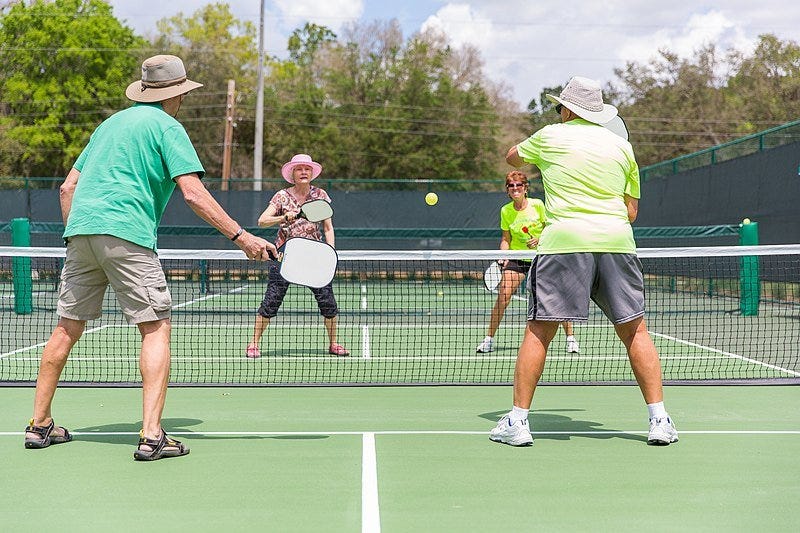HOUSING | What the Pickleball Boom Tells Us About Housing
Access shouldn’t be a zero-sum game
Written By Aaron Lubeck
The paint was barely dry on the newly requisitioned pickleball courts on Duke’s East Campus where two tennis courts previously existed. Less than a month after conversion, the pickleball courts were filled to capacity while the remnant tennis courts lay fallow. Like housing in the South, pickleball is booming. The number of players has doubled in seven years, fast outpacing its lumbering uncle. The sport’s growth has triggered an associated land grab, which makes it an apt analogy to explain the region’s housing shortages.
In North Carolina’s Triangle, those who manage tennis courts have been tasked with building pickleball facilities to meet demand. They have acted quickly, but their response has been somewhat bizarre. At Hollow Rock, all three tennis hard courts were converted into temporary pickleball courts. At Duke Faculty Club, two courts were converted into four pickles. In Chapel Hill, public courts are consistently being taken over by the paddle people.
Private clubs and public parks are indeed building pickleball courts, but rather than build new ones, they are choosing to displace the sport of tennis. And this is causing predictable tensions:
Tennis players have fewer choices and are more likely to not get a court when they want one, which makes them angry.
Some traditionalist tennis players loathe the plastic sound of the pickleball and find it (and the noise from its faster pace and social nature) distracting. So they lobby against access for the new entrants. Hollow Rock recently had a heated debate as to whether it was a racquet club, or a tennis club—the distinction only recently being relevant, apparently.
As our friends at Triangle Blog-Blog recently wrote, “Not since the days of the Hatfields and McCoys has there been an issue dividing communities like this one is.”
There is a solution, of course: Simply build more new pickleball courts. In virtually every instance in the Triangle, there is ample acreage to build new courts that do not displace old interests. But it’s not happening. Why?
The housing story parallels. If we can treat pickleball as non-traditional tennis, we can compare it to the explosion in non-traditional households: Single-person households are now almost a third of the market, and half of U.S. homes have no children present at all. The days of Norman Rockwell appear to be dwindling, if not over.
This data indicates cities should allow more choices than large single-family housing on large single-family lots, a housing type that dominated construction from 1950 to today and is now oversupplied.
Correlating with non-traditional households, there is now exploding demand for non-traditional housing, which could loosely be defined as anything other than large-lot single-family homes. Specifically, it includes Missing Middle Housing—duplexes, triplexes, townhomes, mansion apartments, and the communal living gradients of co-living, compound living, and pocket neighborhoods.
When those non-traditional households demand non-traditional housing in heavily restricted traditional housing markets, conflict is inevitable. Just like when upstart pickleball players enter traditional tennis clubs, the incumbents can feel threatened. Why? Partially because of stasis bias, as people naturally fear change. At other times, it's territorial. If the pickleballers take three courts today, what's to keep them from taking three more tomorrow? This friction echoes the ethnic neighborhood discord of a century ago. At its core, it’s an insular defense of culture. It’s FYIGM (look it up). It is zero-sum, scarcity thinking. It implies that if you’re going to have more fun, I have to have less. Framed this way, the Overton window prevents any discourse about simply building more.

At the end of the day, pickleball is a growing sport in a growing region. It’s coming. You can’t stop it. You can complain all you want about it on listservs. You can slander the pickleballers on social media. But trying to stop them is like trying to stop water flowing downhill. Eventually, they will find their way through. Rather than fight it, we could celebrate the joy the new sport brings the many people who play it. If we don’t create new pickleball courts, tennis players get displaced. If we do create them, they don’t. Simply put, the cities of Raleigh, Durham, and Chapel Hill, and their private clubs, should rapidly build more pickleball courts. And while they are at it, put up some housing, too.
Aaron Lubeck, Jacobs Columnist, is a new urban builder and land planner in Durham, North Carolina. He is the author of Green Restorations: Sustainable Building in Historic Homes, and a children’s book on Accessory Dwellings entitled Heather Has Two Dwellings, and host of the National Townbuilder Association’s “Townbuilder’s Podcast”. @aaron_lubeck


